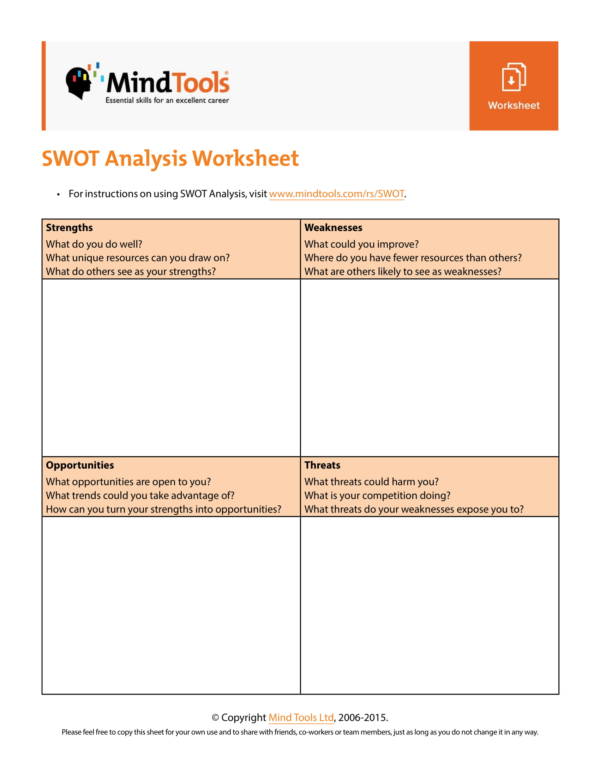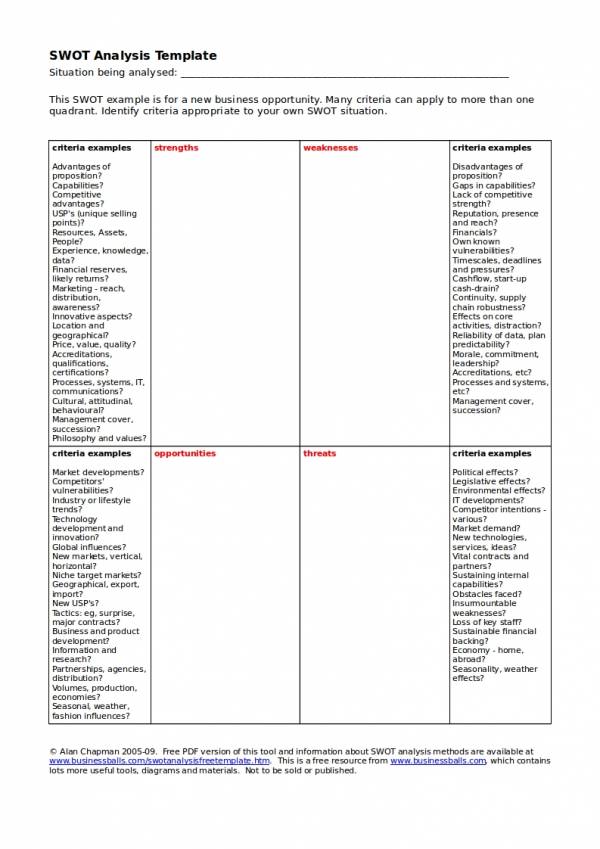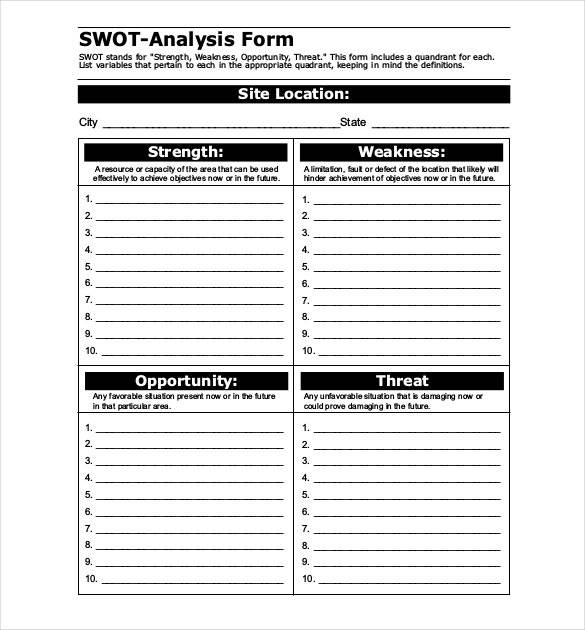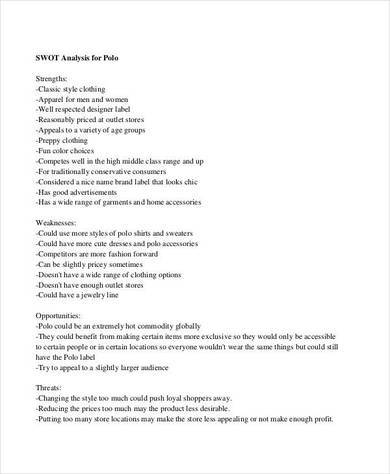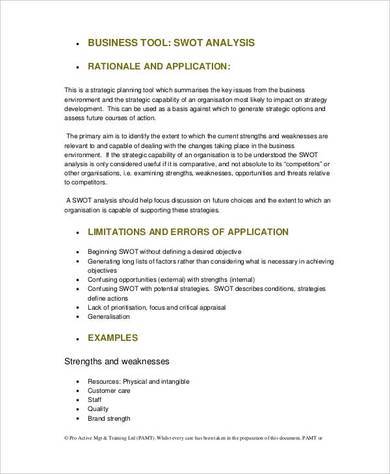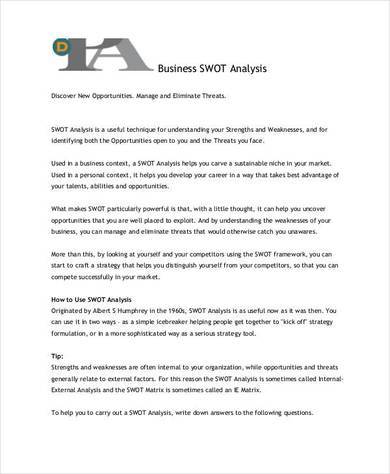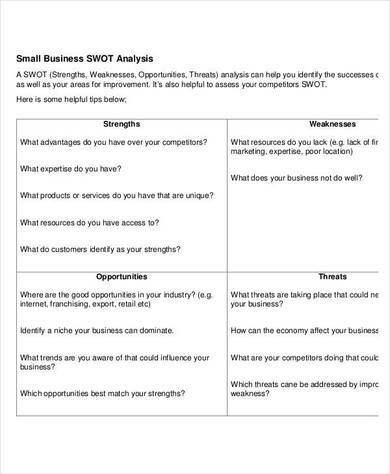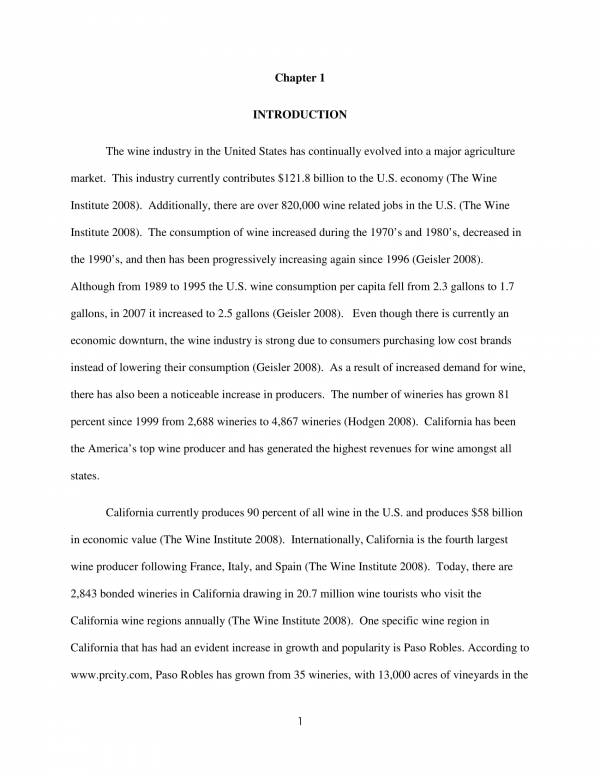Business planning is important for any business regardless if they are existing businesses or just about to start one. Without a business plan, one may have a really difficult time managing their businesses well as its resources. They can easily lose sight of their goals and objectives and may possibly end up unsuccessful with it.
Another tool that is important in a business is a SWOT analysis. Doing a SWOT analysis on your business plan will greatly benefit your business and help you create a business plan that is not only effective, but also relevant at the same time. So that you would understand SWOT analysis business plans better, we have included useful templates that will serve as your reference. Feel free to check them out below.
Restaurant Sustainability SWOT Analysis Sample
SWOT Analysis Worksheet Template
Example of Detailed SWOT Analysis
Business SWOT Analysis Template
Free SWOT Analysis Form
What Does SWOT Mean in a Business Plan?
Planning, implementation and continuous monitoring are essential steps in managing a business. This requires a tool that can offer a lot of benefits and advantages to the business such as a business plan swot analysis. A SWOT analysis is a popular and useful tool whose components consist of strengths, weakness, opportunities and threats, which is what the acronym also stands for. These components are categorized into internal factors and external factors. Internal factors are those that can be controlled such as strengths and weaknesses, while external factors are beyond one’s control and they are opportunities and threats.
In business, a SWOT analysis is used to determine the strengths, weaknesses of a business as well as the opportunities that they may take advantage of and the threats that they need to pay attention to.
The strengths of a business mainly refers to its capabilities and its resources that gives it its advantage over the competition. Having loyal customers and a well-recognized brand name are also some of the things that count as a business strength.
The opposite of strengths are weaknesses and that means poor brand recognition qualifies as a weakness. This includes unreliable and overprices services or insufficient marketing budget. Identifying the weaknesses of the business is important as this allows the business find ways for improvement as well as how they will position themselves against much better competition.
Opportunities are circumstances that become available to a business for a particular time. A business may take advantage of these opportunities to help their company, grow, expand or become successful with whatever they aim to achieve. These opportunities may also hinder a business from achieving its goals. It all depends on the situation or circumstances.
Threats are seen as potential harm to a business if not attended to or action is not taken to prepare for it or minimize its occurrence. Since this is an external factor, the only thing that a business can do to avoid damages or losses is to plan and prepare for it because it will always be there. Different situations call for different threats.
You may also want to check out other related articles, like Competitor SWOT Analysis Samples & Templates, Detailed SWOT Analysis Samples & Templates, and Manager SWOT Analysis Samples & Templates.
How to Conduct a SWOT Analysis for Your Business Plan
There are many ways on how a SWOT analysis can be conducted and they all depend on certain factors, like where it is going to be used on, what industry is involved, the current situation or circumstances and the purpose for having a SWOT analysis done. It also depends on one’s preferences and style. Here, we will show you how to conduct a SWOT analysis for your business using four simple and easy to follow steps.
Step #1: List down the SWOT of your business.
List down as many of the strengths, weaknesses, opportunities and threats of your business that you know of. Make sure to categorize or group them accordingly and they should all be related to your business. Once you have all the details listed down, prioritize them by putting the most important ones on top and the least important ones at the bottom.
Step #2: Group your strengths.
The next thing that you would want to do is to divide your strengths and put them into two different groups. One group should be the strengths of your business that will help you take advantage of the opportunities that are currently available to your business or those strengths that will help you face your business opportunities. The other group should consist of strengths that will help you ward off potential threats that may harm your business or negatively impact your business.
Step #3: Group your weaknesses.
In this step you will also divide your weaknesses and put them into two groups, just like what you did with your business strengths. Since weaknesses are those things that needs improvement, the first group should consist of your business’ weaknesses that can be improved and that needs to be improved for you to be able to take advantage of opportunities. The second group on the other hand are those weaknesses that must be improved completely in as soon as possible or must be converted into your business strengths to help keep your business away from potential threats. Just like your business strengths, your business weaknesses are also grouped based on your business opportunities and threats.
Step #4: Use the list that you just made.
Now that your list of strengths, weaknesses, opportunities and threats is complete and organized, you now have a basis or source of information that you can refer to while creating your business plan. Through the list, you can create effective strategies to achieve your business goals, as well as create an action plan to address your weaknesses and threats.
Using a SWOT analysis template or grip will best help you with conducting your SWOT analysis as it provides you with an already formatted tool where you can list down all the necessary details. To be able to get SWOT analysis templates, like College SWOT Analysis Samples, Hospital SWOT Analysis Samples & Templates, and Business SWOT Analysis Samples & Templates just check out our website.
How to Create Your Own SWOT Analysis Template
A SWOT analysis is a simple yet very useful tool that uses a very simple template that you can create on your own. No special skills or talent needed, and definitely no special tools. Follow the steps below to help you with creating your very own SWOT analysis template.
- It’s good if you have already seen a SWOT analysis template before or if you have done a SWOT analysis before. This will give you an idea on the details that you must include on your template. If not, it would be wise to check out some samples or templates that are available online.
- Now that you know what a SWOT analysis looks like and what its parts are, you need to create an outline based on how you want your SWOT analysis template to be. You don’t have to follow the same format as other templates, you can create your own as long as it is appropriate for our needs.
- When you have the outline in place, get the materials that you need for creating your template.
- Using the outline that you have prepared ahead, start creating your SWOT analysis template. You can choose to write the title or main parts and draw the objects you want to include, if any.
- Then proceed with labeling all the parts and objects that must be labelled. This done so that you will know where specific information will go and won’t be confused with them once you need to use them.
- Review your work. Check for any missing details, wrong spelling, missing objects, etc. Compare it with your own outline or with an existing template that you used as reference.
- When you are satisfied with it, you may print copies of it for future use or save the file so that you may have something to edit and use if you need to.
With the steps provided above, you can create and adapt to your own style of creating a SWOT analysis template that is appropriate for your needs. If you needs more samples and templates then feel free to them out on our website. We have there Marketing SWOT Analysis Samples & Templates, Sample Employee SWOT Analysis Template, and HR SWOT Analysis Samples & Templates.
Fashion Retail SWOT Analysis
Free Business SWOT Analysis
New Business SWOT Analysis
Small Business SWOT Analysis
SWOT Analysis for General Store
Advantages of Using SWOT Analysis Templates
The following are the advantages of using SWOT analysis templates.
- Using SWOT analysis templates allows you to a lot of time as everything that you need is already in it. You just need to have it printed, fill in the required information and you are good to go.
- The template eliminates the need for you to create a new one every time you need it.
- It is easy and convenient for use. Anyone who needs it can absolutely use it.
- It is editable and printable.
- It is available in different user-friendly file formats, like PDF and Word.
- SWOT analysis templates are available online for free in most websites.
What else can you ask for in a SWOT analysis template? It surely is simple yet useful. No wonder it is considered as one of the many business analysis tools that are currently in use today. Other related topics you may be interested in are Hotel SWOT Analysis Samples & Templates, Student SWOT Analysis Template, and Retail SWOT Analysis Samples &Templates.
Related Posts
FREE 10+ Fishbone Root Cause Analysis Samples in PDF
FREE 11+ Cost Volume Profit Analysis Samples & Templates in PDF | MS Word
FREE 6+ Corporate Portfolio Analysis Samples in PDF
FREE 10+ Fault Tree Analysis Samples in PDF
FREE 10+ Comp Analysis Samples in PDF
FREE 10+ Fishbone Analysis Samples in PDF
FREE 10+ Individual Swot Analysis Samples in PDF
FREE 10+ 5 Year Analysis Samples in PDF
FREE 10+ Benefit Costs Analysis Samples in PDF
FREE 10+ Job Hazard Analysis Samples in PDF
FREE 10+ Primary Source Analysis Samples in PDF
FREE 10+ Critical Path Analysis Samples in PDF
FREE 10+ Competition Analysis Samples in PDF
FREE 10+ Activity Hazard Analysis Samples in PDF
FREE 10+ Risk Benefit Analysis Samples in PDF


